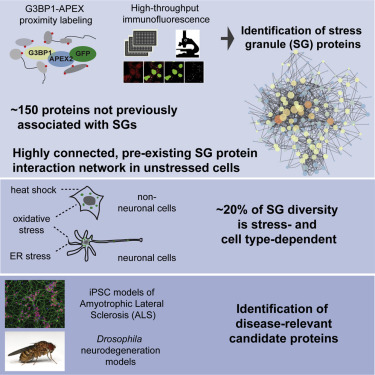Our official English website, www.x-mol.net, welcomes your
feedback! (Note: you will need to create a separate account there.)
Context-Dependent and Disease-Specific Diversity in Protein Interactions within Stress Granules.
Cell ( IF 45.5 ) Pub Date : 2018-Jan-25 , DOI: 10.1016/j.cell.2017.12.032 Sebastian Markmiller 1 , Sahar Soltanieh 2 , Kari L Server 1 , Raymond Mak 3 , Wenhao Jin 4 , Mark Y Fang 1 , En-Ching Luo 1 , Florian Krach 1 , Dejun Yang 5 , Anindya Sen 6 , Amit Fulzele 3 , Jacob M Wozniak 7 , David J Gonzalez 7 , Mark W Kankel 6 , Fen-Biao Gao 5 , Eric J Bennett 3 , Eric Lécuyer 8 , Gene W Yeo 9
Cell ( IF 45.5 ) Pub Date : 2018-Jan-25 , DOI: 10.1016/j.cell.2017.12.032 Sebastian Markmiller 1 , Sahar Soltanieh 2 , Kari L Server 1 , Raymond Mak 3 , Wenhao Jin 4 , Mark Y Fang 1 , En-Ching Luo 1 , Florian Krach 1 , Dejun Yang 5 , Anindya Sen 6 , Amit Fulzele 3 , Jacob M Wozniak 7 , David J Gonzalez 7 , Mark W Kankel 6 , Fen-Biao Gao 5 , Eric J Bennett 3 , Eric Lécuyer 8 , Gene W Yeo 9
Affiliation

|
Stress granules (SGs) are transient ribonucleoprotein (RNP) aggregates that form during cellular stress and are increasingly implicated in human neurodegeneration. To study the proteome and compositional diversity of SGs in different cell types and in the context of neurodegeneration-linked mutations, we used ascorbate peroxidase (APEX) proximity labeling, mass spectrometry, and immunofluorescence to identify ∼150 previously unknown human SG components. A highly integrated, pre-existing SG protein interaction network in unstressed cells facilitates rapid coalescence into larger SGs. Approximately 20% of SG diversity is stress or cell-type dependent, with neuronal SGs displaying a particularly complex repertoire of proteins enriched in chaperones and autophagy factors. Strengthening the link between SGs and neurodegeneration, we demonstrate aberrant dynamics, composition, and subcellular distribution of SGs in cells from amyotrophic lateral sclerosis (ALS) patients. Using three Drosophila ALS/FTD models, we identify SG-associated modifiers of neurotoxicity in vivo. Altogether, our results highlight SG proteins as central to understanding and ultimately targeting neurodegeneration.
中文翻译:

应激颗粒内蛋白质相互作用的上下文相关和疾病特异性多样性。
应激颗粒 (SGs) 是在细胞应激过程中形成的瞬时核糖核蛋白 (RNP) 聚集体,并且越来越多地涉及人类神经退行性变。为了研究不同细胞类型和神经变性相关突变背景下 SG 的蛋白质组和组成多样性,我们使用抗坏血酸过氧化物酶 (APEX) 邻近标记、质谱和免疫荧光来鉴定 150 种以前未知的人类 SG 成分。无压力细胞中高度集成的、预先存在的 SG 蛋白相互作用网络有助于快速合并成更大的 SG。大约 20% 的 SG 多样性是压力或细胞类型依赖性的,神经元 SG 表现出特别复杂的蛋白质库,富含伴侣蛋白和自噬因子。加强 SGs 与神经退行性变之间的联系,我们展示了肌萎缩侧索硬化症 (ALS) 患者细胞中 SGs 的异常动力学、组成和亚细胞分布。使用三个果蝇 ALS/FTD 模型,我们确定了体内神经毒性的 SG 相关修饰剂。总而言之,我们的研究结果强调 SG 蛋白是理解和最终靶向神经退行性疾病的核心。
更新日期:2018-01-25
中文翻译:

应激颗粒内蛋白质相互作用的上下文相关和疾病特异性多样性。
应激颗粒 (SGs) 是在细胞应激过程中形成的瞬时核糖核蛋白 (RNP) 聚集体,并且越来越多地涉及人类神经退行性变。为了研究不同细胞类型和神经变性相关突变背景下 SG 的蛋白质组和组成多样性,我们使用抗坏血酸过氧化物酶 (APEX) 邻近标记、质谱和免疫荧光来鉴定 150 种以前未知的人类 SG 成分。无压力细胞中高度集成的、预先存在的 SG 蛋白相互作用网络有助于快速合并成更大的 SG。大约 20% 的 SG 多样性是压力或细胞类型依赖性的,神经元 SG 表现出特别复杂的蛋白质库,富含伴侣蛋白和自噬因子。加强 SGs 与神经退行性变之间的联系,我们展示了肌萎缩侧索硬化症 (ALS) 患者细胞中 SGs 的异常动力学、组成和亚细胞分布。使用三个果蝇 ALS/FTD 模型,我们确定了体内神经毒性的 SG 相关修饰剂。总而言之,我们的研究结果强调 SG 蛋白是理解和最终靶向神经退行性疾病的核心。











































 京公网安备 11010802027423号
京公网安备 11010802027423号